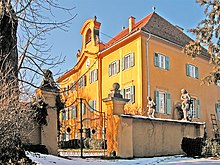Hermann Schischegg
Hermann Schischegg (* 1878 in Marburg an der Drau , † 1960 in Graz ) was a Slovenian - Austrian photographer , printer and entrepreneur , among other things in the field of picture postcards .
Life
The 1878 later in Maribor born Hermann ski Schegg learned the photographic craft during his working in Maribor Uncle Ludwig Kieser , the early 20th century in Munich make and with a bronze plaque from 1911 for 15 years of membership in a photographic association honored purveyors .
In 1912 Schischegg set up a “photocopier for picture postcards” in Graz, but before 1915 he was also working as a portrait photographer at 3 Körösistraße .
Returning to Graz from the First World War in 1920 , Hermann Schischegg set up a studio at Körösistraße 3 , which he moved to the apartment at Neutorgasse 2 in 1922 and to 7 Rosenkranzgasse in 1929 .
An interior shot of the Annenhof cinema by Schischegg made in 1923 was used almost a century later as an illustration of the history of the cinema .
Above all in 1924, prints of Schischeck's photographs appeared in the Grazer Illustrierte Dasinteresting sheet under titles such as “Singer trip of the Viennese postal workers to Graz” or “Prisoners of war and returnees”, but also “Jägertag” and “Congress to combat trafficking in girls and children ".
For the years 1925 to 1929 Schischegg was a member of the Styrian State Cooperative of Photographers .
In 1929, Schischeggs advertised the "Photodruckanstalt", also known as the "Express-Druckanstalt", with the "mass production of bromide silver postcards", later also with the handling of urgent orders within hours and, among other things, as a photo postcard printing company.
From November 11, 1932, Hermann Schischeck took part in a group exhibition with photographs on the subject of "animal studies" shown by the State Cooperative of Photographers for Styria and the State Trade Promotion Service in the Graz Chamber of Commerce .
From 1934 onwards, Schischegg added a photo shop to his company, soon trading as Photohaus Schischegg .
From the year Austria was annexed by the National Socialist Third Reich , Schischegg ran his company from 1938 onwards at Flamhof Castle in Sankt Nikolai im Sausal , at times also named "Flamberg".
In the year of the beginning of the Second World War , Hermann Schichegg's business registration was canceled in 1939, but after Franz Schrattenhofer took over his company, Schischegg only withdrew from the business in 1940, which was still known in 1943 as "Photohaus Schischegg".
A "SKI Schegg, Hermann" was sometimes as undercover agent in Sicherheitsdienst operates.
Archival material
Archives by and about Hermann Schischegg can be found, for example
- in the picture and sound archive of the Landesmuseum Joanneum in Graz, which in 1995 bought “several albums, loose positive copies and postcards as well as an album with pictures of the pageant on the occasion of the 1923 hunting exhibition”.
Web links
- oV : Schischegg, Hermann in the database of the Albertina Collections Online
- Postcard collection… Publisher: Hermann Schischegg on the GrazMuseum website
Individual evidence
- ↑ a b c d e f g h i j k l Compare the information and cross-references in the database of the Albertina Collections Online as edited on November 19, 2003, last accessed on October 20, 2017
- ↑ Compare the Photographische Chronik… , Vol. 18, Wilhelm Knapp, 1911, p. 293; Preview over google books
- ↑ Christoph Pelzl: Kinogeschichte - About “settling down” and the right accompanying music / Museum für Geschichte on the museum-joanneum.at page of February 26, 2014, last accessed on October 20, 2017
- ^ Compare the Historical Yearbook of the City of Graz , Stadtmuseum Graz , Vol. 23–24, 1993, p. 397; Preview over google books
| personal data | |
|---|---|
| SURNAME | Schischegg, Hermann |
| BRIEF DESCRIPTION | German photographer, printer, entrepreneur and postcard producer |
| DATE OF BIRTH | 1878 |
| PLACE OF BIRTH | Marburg on the Drau |
| DATE OF DEATH | 1960 |
| Place of death | Graz |
